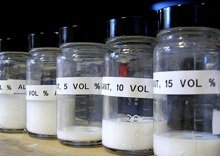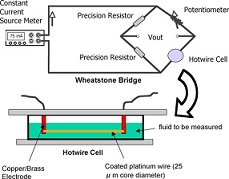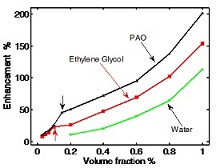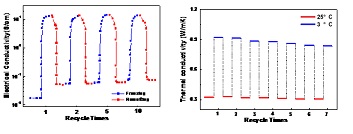Nanofluids
Over the past decade, nanofluids, which are liquids containing suspensions of nanoparticles (Fig. 1), have been reported to possess substantially higher thermal conductivity than anticipated from the effective medium theories. This makes them very attractive as heat transfer fluids in many applications. For example, nanofluids would be useful as coolants in the automobile and electronics industries. However, the reported high thermal conductivity sometimes cannot be reproduced, and the potential mechanisms leading to the enhancement are still under scrutiny. Due to these reasons, nanofluids have been a controversial topic.
Heat Conduction Mechanisms
In our experimental investigations, we use graphite flakes as additives and developed methods to prepare stable graphite suspensions. We then studied the thermal conductivity of graphite suspensions by using the transient hotwire method (Fig. 2). Our suspensions achieved record high thermal conductivity values in different base fluids including water, engine oil, and ethylene glycol (Fig. 3). The thermal conductivities of graphite suspensions are very sensitive to the internal structures, and a sharp kink behavior in the thermal conductivity curves can be observed. Combining the optical technique and AC impedance spectroscopy method, the sharp transition can be interpreted as the result of the change of interaction forces between graphite flakes when isolated graphite clusters percolate to form a 3D network.
Reversible temperature regulation of suspension properties
Reversible temperature tuning of electrical and thermal conductivities of materials is of interest for many applications, including seasonal regulation of building temperature, thermal storage and sensors. We have found a general strategy to achieve large contrasts in electrical and thermal conductivities using first-order phase transitions in percolated composite materials. Internal stress generated during a phase transition modulates the electrical and thermal contact resistances, leading to large contrasts in the electrical and thermal conductivities at the phase transition temperature. With graphite/hexadecane suspensions, the electrical conductivity changes 2 orders of magnitude and the thermal conductivity varies up to 3.2 times near 18 °C (Fig. 4). The generality of this approach is also demonstrated in other materials such as graphite/water and carbon nanotube/hexadecane suspensions.
References
- J.W. Gao, R.T. Zheng, H. Ohtani, D.S. Zhu, and G. Chen, Experimental investigation of heat conduction mechanisms in nanofluids - clue on clustering, Nano Letters, Vol. 9, pp. 4128-4132, 2009.
- R.T. Zheng, J.W. Gao, J.J. Wang, and G. Chen, Reversible temperature regulation of electrical and thermal conductivity using liquid-solid phase transitions, Nature Communications, Vol. 2, 289, 2011.
- R.T. Zheng, J.W. Gao, J.J. Wang, H.P. Feng, H. Ohtani, J.B. Wang, and G. Chen, Thermal percolation in stable graphite suspensions, Nano Letters, Vol. 12, pp. 188-192, 2012



